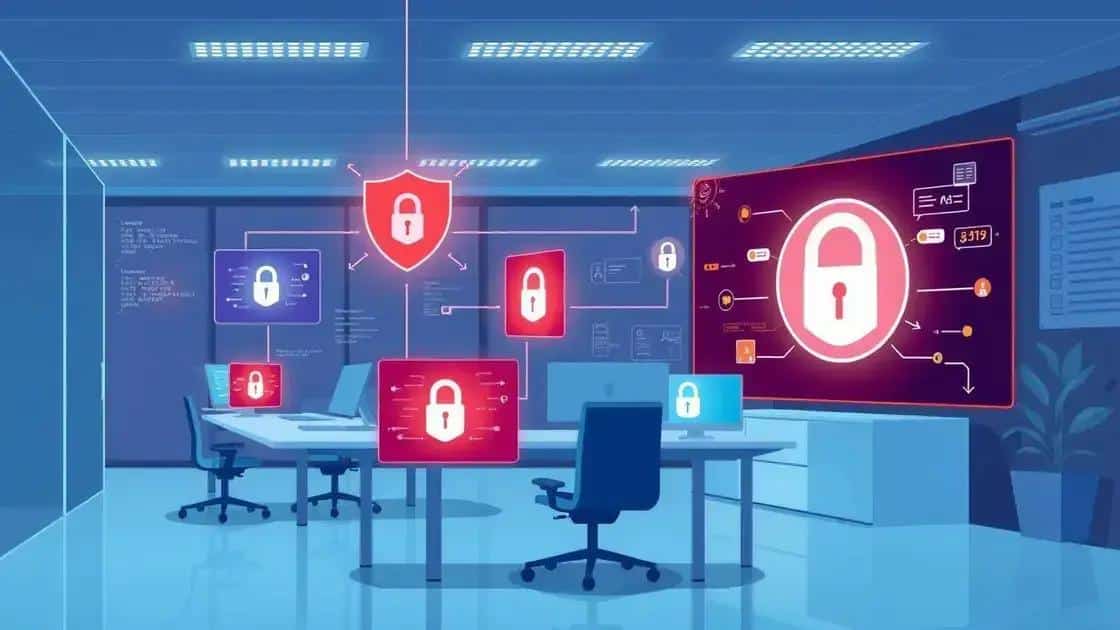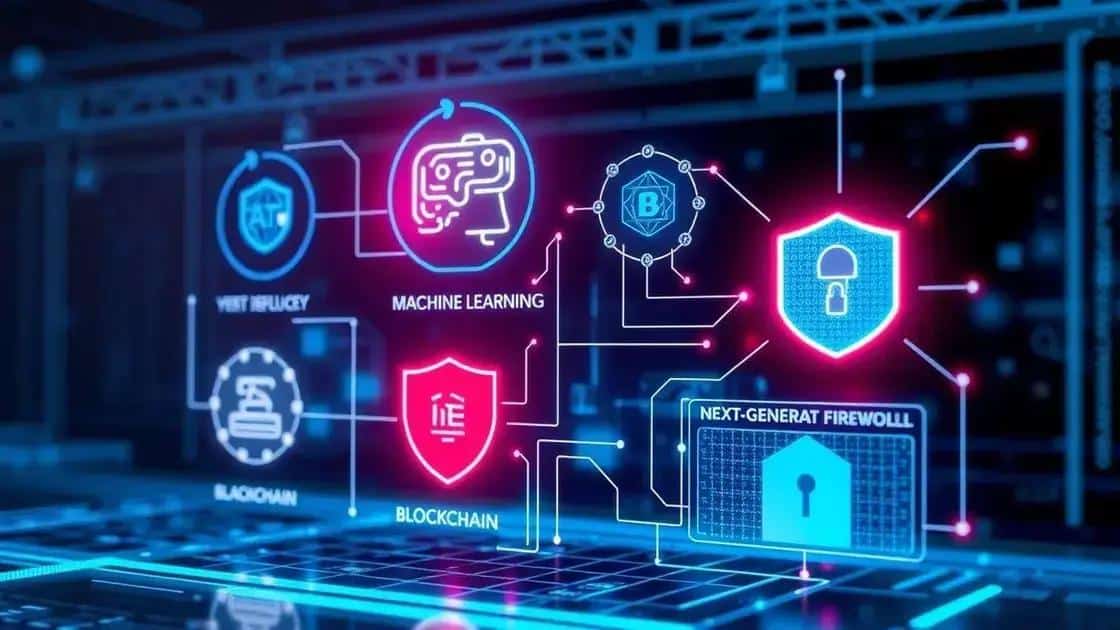Upon cybersecurity threats 2025: Are you prepared?

Cybersecurity threats in 2025 require individuals and organizations to embrace advanced technologies, adhere to legislation, and follow best practices to effectively safeguard sensitive information and mitigate risks.
Upon cybersecurity threats 2025, many individuals and companies are left wondering what steps they should take to fortify their defenses. With new risks emerging regularly, it’s essential to stay ahead and understand how these threats can impact your security.
Understanding the landscape of cybersecurity threats
Understanding the landscape of cybersecurity threats is essential for both individuals and organizations. With technology evolving rapidly, so do the methods used by cybercriminals. Knowing these threats helps in developing effective defense strategies.
The Types of Cybersecurity Threats
Cybersecurity threats can take many forms. They can be classified into various types, each with unique characteristics and implications. Some common types include:
- Malware: Malicious software designed to harm or exploit any programmable device.
- Phishing: Attempts to trick users into exposing sensitive information through fake emails or websites.
- Ransomware: A type of malware that encrypts data and demands a ransom for its release.
- Denial-of-Service Attacks: Flooding a network or service to overwhelm and disrupt operations.
Understanding these categories helps prioritize your security efforts. Additionally, it’s important to recognize that the landscape is continually changing.
Factors Influencing Cybersecurity Threats include advancements in technology, changes in user behavior, and the growth of the internet of things (IoT). As these technologies become more integrated into daily life, vulnerabilities can increase.
For instance, the increase in remote work following global shifts has led to new opportunities for cyberattacks. Employees accessing company resources from home can create weak points in security systems.
Recognizing Emerging Threats
As we progress into 2025, staying informed about emerging threats is crucial. Some trends to watch include:
- Rise of artificial intelligence in cyberattacks.
- Increased use of IoT devices which may lack proper security measures.
- Growing sophistication of phishing techniques, making them harder to detect.
Staying aware of these potential threats is vital. Always keep your software updated and educate yourself about the latest occurrences in cybersecurity. The more informed you are, the better you can protect yourself and your organization.
The evolving tactics of cybercriminals
The tactics used by cybercriminals are continuously evolving, making it crucial for individuals and organizations to stay vigilant. As technology advances, so do the strategies that criminals employ to exploit vulnerabilities.
New Methods of Attack
Cybercriminals are always looking for innovative ways to breach security. Some of the new methods include:
- Social Engineering: Manipulating individuals into revealing confidential information.
- Advanced Persistent Threats (APTs): Long-term sneak attacks on a targeted organization.
- Zero-Day Exploits: Attacks that occur on the same day a vulnerability is discovered, before developers can issue patches.
- Credential Stuffing: Using stolen account details to gain unauthorized access to multiple accounts.
These tactics illustrate the need for comprehensive cybersecurity measures. As cybercriminals grow more sophisticated, traditional defenses may not be enough.
Another trend is the rise in the use of malware-as-a-service. This allows even inexperienced criminals to launch effective attacks using tools and programs that they purchase online. As a result, the barrier to entry into cybercrime is lower than ever, and more individuals are getting involved.
Targeting Vulnerabilities
Today’s criminals focus not only on technical flaws but also on human behaviors. They exploit weaknesses in employee training and organizational structures. By understanding where vulnerabilities lie, criminals can design better attacks. For instance, an increase in remote work has created new avenues for attack as employees may not have adequate home security measures.
Additionally, IoT devices with weak security are commonly targeted. Many devices are left with default passwords or minimal security features, making them an easy entry point for cybercriminals. Organizations must remain aware of these risks and update their security protocols accordingly.
In recent years, the rise of deepfakes has also changed the landscape of cybercrime. By creating fake videos or audio recordings, criminals can manipulate people or companies into trust-based decisions, further complicating the realm of cybersecurity.
Emerging technologies against cybersecurity threats

Emerging technologies play a crucial role in combating cybersecurity threats. As cybercriminals develop more sophisticated methods, new technologies are being created to counteract these risks effectively.
AI and Machine Learning
One of the most significant advancements is the use of artificial intelligence (AI) and machine learning (ML)
AI and ML not only enhance security measures but also minimize the need for constant human oversight. Another exciting innovation is the utilization of blockchain technology. Originally created for cryptocurrencies, blockchain’s features can enhance security in various applications. Its decentralized nature makes it difficult for cybercriminals to alter or hack data stored on a blockchain. This means that sensitive information can be better protected against unauthorized access. The advancement of firewalls has also contributed significantly to cybersecurity. Next-generation firewalls provide deep packet inspection, filtering traffic based on applications rather than just ports or protocols. These firewalls enhance security by: As technology continues to evolve, it’s vital for organizations to stay updated on the latest developments. In addition, the rise of quantum computing is on the horizon. While still in development, this technology promises to revolutionize encryption methods. Quantum systems could potentially make current encryption techniques obsolete, leading to the need for entirely new strategies to protect sensitive data. Implementing best practices for cybersecurity is essential for both individuals and organizations. Establishing a strong foundation in security can significantly reduce the risk of cyber threats. One of the simplest yet most effective practices is to keep all software up to date. Regular updates patch vulnerabilities that cybercriminals often exploit. This includes not just operating systems but also applications and antivirus programs. Remember, outdated software becomes a prime target for attacks. Another important aspect is conducting regular security audits. These audits help identify weaknesses in your security posture. By evaluating your systems regularly, whether through internal assessments or external consultants, you can find areas that need improvement. Using strong passwords is crucial in defending against cyberattacks. Passwords should be complex, combining letters, numbers, and symbols. Instead of reusing passwords across multiple accounts, consider using a password manager. This tool can help generate and store unique passwords securely. Education is also a key component of security practices. Organizations should train their employees on recognizing threats such as phishing emails. Employees who understand common tactics used by cybercriminals are less likely to fall victim. Additionally, make use of security tools like firewalls and antivirus software. These tools act as barriers against many types of cyber threats. Each serves as an additional layer of protection, ensuring that even if a security measure fails, others remain in place. Establishing a consistent data backup strategy is vital. Regularly backing up important data ensures that in the event of a ransomware attack or data loss, the information can be recovered. Use both cloud storage and physical drives for backups. This dual approach provides greater security and accessibility. Always have an incident response plan in place. This plan outlines the steps to take in the event of a cyber incident, helping to minimize damage and ensure a prompt response. A well-prepared organization can significantly mitigate the impact of a breach. The role of legislation in cybersecurity is vital in creating a safe digital environment. Laws and regulations guide how organizations protect data and manage cyber threats. They pave the way for accountability and compliance. Legislation helps establish frameworks that govern data protection and cybersecurity practices. For example, the General Data Protection Regulation (GDPR) in the European Union sets strict guidelines on data privacy and protection. Organizations must adhere to these regulations to avoid hefty fines. Compliance with laws is essential for building trust with customers. When businesses follow legal requirements, it shows they prioritize customer data. This trust can lead to stronger relationships and loyalty. Governments often create policies that encourage better cybersecurity practices. Policies may include: Such measures not only protect citizens but also improve national security. A secure infrastructure supports the economy and minimizes vulnerabilities. As technology evolves, so do legal requirements. New laws are introduced to address emerging threats, such as ransomware and hacking incidents. Staying updated on legislation is crucial for organizations to navigate the complex landscape of cybersecurity successfully. Cybersecurity is a global issue, which highlights the importance of international laws and treaties. Many countries collaborate to combat cybercrime, sharing intelligence and resources. For instance, the Budapest Convention on Cybercrime helps member countries coordinate efforts to tackle cyber threats effectively. This kind of cooperation is essential for enforcing laws across borders, as cybercriminals often operate internationally. By working together, nations can enhance their ability to respond to incidents and hold offenders accountable. Cybersecurity legislation helps create standards for data protection and responsible handling of sensitive information, ensuring a safer digital environment. Stay informed about relevant laws, conduct regular audits, and implement necessary security measures to align with legal requirements. Some notable laws include the GDPR in Europe, HIPAA in the U.S. for healthcare data, and the CCPA in California for consumer privacy rights. Legislation facilitates international cooperation, mandates reporting of breaches, and promotes better cybersecurity practices among businesses.
Next-Generation Firewalls
Best practices for individuals and organizations
Regular Software Updates
Strong Password Management
Data Backup Strategies
The role of legislation in cybersecurity
Establishing Frameworks
Cybersecurity Policies
International Cooperation
FAQ – Frequently Asked Questions about Cybersecurity Legislation
What is the importance of cybersecurity legislation?
How do I ensure my organization complies with cybersecurity laws?
What are some common cybersecurity laws to be aware of?
How can legislation help combat cybercrime?






